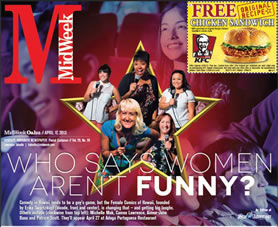Who Says Women Aren’t Funny?
Scott: “My first gig was at a funeral at age 5. I made faces and exchanged jokes with a family friend, who referred to me as ‘the little comedian.’ Today, I’m an actor too, and I’ve done a lot of local theater. (The Twits, August: Osage County, The Graduate and Three Tall Women, among others) In the second grade, I wrote an essay about wanting to be a comedian. The paper came back with a big red X on the page with the teacher comment, ‘This is not a joke. Write about something that’s actually possible.’ I cried.”
Baxa: “Being the youngest child, I always wanted attention and liked performing at school. I always knew I could make people laugh. I’ve worked professionally with emcee-entertainment producer Kaleo Pilanca and opened for Mel Cabang and others.”
Mak: “I got started on a dare. A friend coaxed me into doing an open mic appearance, and although he didn’t show up, 20 other friends did and genuinely laughed at my stuff. I was hooked.”
Lawrence: “My interest in comedy began as a young girl being raised in Queens, N.Y. I entered comedy competitions to showcase my talents and did fairly well. I’ve appeared the last several years in Laugh Track theatre productions as well as at many local clubs.”
Laa: (On Twitter) “I’m so happy watch(ing) the guy who inspired me to start being a comedian. Thank you, Gabriel Iglesias.”
Do you do any open mics (live shows where audience members may perform)?
Swartzkopf: “I go two or three times a week. Open mics – at places like Edge Bar, Station Bar, Indigo Comedy Club – give you an opportunity to work new material and hear audience reaction.”
Scott: “Some open mics are not chick-friendly, but it’s a place where comics can work out. It’s our weight room.”
You each write your own material. Where does the inspiration come from?
Swartzkopf: “Everyday life, such as identifying ways to tell if you are local.
If you come home from a party with mismatched slippers that are not yours, you could be a local. If you have more guitars and surf-boards than people in your house, you could be a local.”
Mak: “One of my recurring themes is, ‘Why white guys love Asian chicks.’ It’s something I’ve experienced a lot and to which a local audience can relate. A flirtatious guy once offered me a lychee martini. Lychee martini? How original, sir. For the record, I may be Asian, but I hate lychee.”
Do female comics take a backseat to men?
Swartzkopf: “No, but there are many more men in comedy than women. We don’t always get the stage time that we want. I named the group ‘Comics’ on purpose, because we don’t want to be set apart from men. Having our own show gives us more power to make decisions. And, no, men are not funnier than women. They’d just like to think so. Funny is funny.”
Baxa: “At open mics, you can get lost in the testosterone.”
Scott: “Because there are so few women who actually pursue stand-up comedy, there are more opportunities for funny women than men, provided they can deliver the goods on stage.”
How do you read an audience?
Lawrence : “By how much they drink.” (Laughs).
Scott: “Don’t you read a crowd from right to left if it’s Asian?”
Swartzkopf: “Our shows tend to be for an older crowd and not for kids. Except for Michelle’s fans.”
Mak: “I seem to draw the under-30s, most of whom are boys.”
Lawrence: “Mine seem to be the Viagra bunch.”
What about profanity in the act?
Scott: “I was born without a censor. If one could gain weight by words, I would weigh a ton because I just say what I want.”
Swartzkopf: “In our shows, there is no censor. We have an understanding of how far you can go. The line between good and bad taste moves so quickly these days that one must be nimble, constantly looking to raise the ante.”
How important is delivery?
Scott: “It’s everything. The best delivery comes from a sense of confidence. People come because they want to laugh. It’s set up already. The comic just has to deliver.”
Swartzkopf: “For me, it’s half and half – 50 percent material, 50 percent delivery. Can’t have one without the other. You don’t want to be tripping over laughs.”
What are your hopes for the group?
Swartzkopf: “We’d love to do an interisland tour. Then, the Mainland. To be able to play L.A. would be the ultimate. We like to think big. As Roseanne Barr says, ‘The thing women have yet to learn is nobody gives you power. You just take it.'”
What’s your advice to aspiring comediennes?
Laa: “Don’t be discouraged if you’re not funny the first time on stage. You’re always your own worst critic. Don’t be afraid to ask other comics for help. They will help you as long as you’re willing to listen and take their advice.”
Or, in the words of Phyllis Diller, “Aim high, and you won’t shoot your foot off.”
Female Comics of Hawaii appear Saturday, April 27, 6:30 p.m., at Adega Portuguesa Restaurant, 1138 Smith St. $40 dinner-show presale tickets only by emailing swartzkopf@yahoo.com or calling 542-8345.







